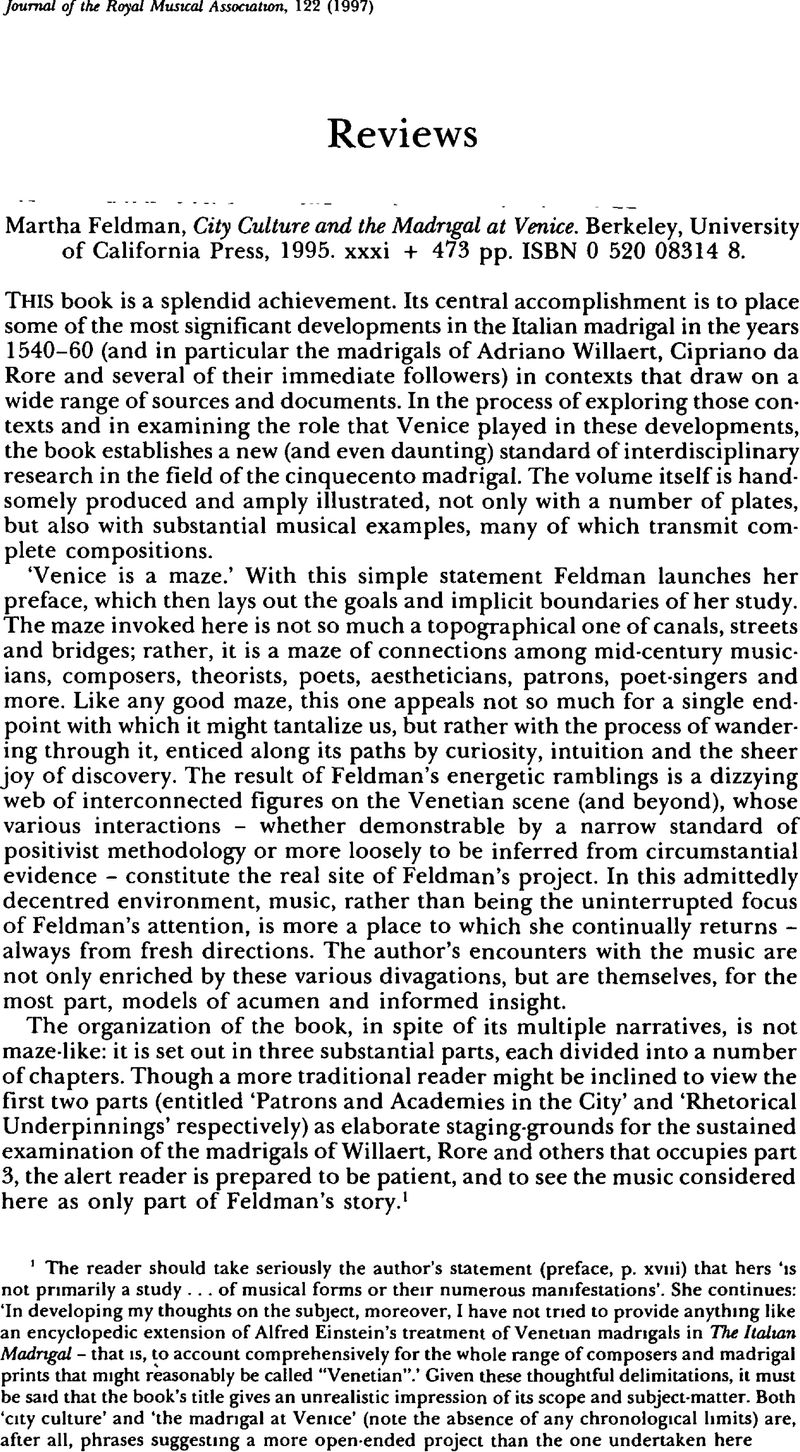No CrossRef data available.
Published online by Cambridge University Press: 01 January 2020

1 The reader should take seriously the author's statement (preface, p. xviii) that hers ‘is not primarily a study … of musical forms or their numerous manifestations'. She continues: ‘In developing my thoughts on the subject, moreover, I have not tried to provide anything like an encyclopedic extension of Alfred Einstein's treatment of Venetian madrigals in The Italian Madrigal – that is, to account comprehensively for the whole range of composers and madrigal prints that might reasonably be called “Venetian”.’ Given these thoughtful delimitations, it must be said that the book's title gives an unrealistic impression of its scope and subject-matter. Both ‘city culture’ and ‘the madrigal at Venice’ (note the absence of any chronological limits) are, after all, phrases suggesting a more open-ended project than the one undertaken hereGoogle Scholar
2 See Einstein, Alfred, The Italian Madrigal, trans. Alexander H. Knappe, Roger H Sessions and Oliver Strunk, 3 vols (Princeton, 1949) Einstein's statement on Bembo can be found in vol i, p 109Google Scholar
3 Mace, Dean, ‘Pietro Bembo and the Literary Origins of the Italian Madrigal’, Musical Quarterly, 55 (1969), 65–86.Google Scholar
4 For the most complete examination of Willaert's work in this genre see Donna G. Cardamone, The ‘Canzone villanesca alla napolitano’ and Related Forms, 1537–1570, 2 vols (Ann Arbor, 1981)Google Scholar
5 A Correspondence of Renaissance Musicians, ed. Bonnie J Blackburn, Edward E, Lowinsky and Clement A. Miller (Oxford, 1991).Google Scholar
6 Lowinsky's comments, cited on p 258, are drawn from the introduction to The Medici Codex of 1518 A Choirbook of Motets Dedicated to Lorenzo de’ Medici, Duke of Urbino, ed. Edward E Lowinsky, 3 vols. (Chicago and London, 1968), i, 80Google Scholar
7 There are further examples of these kinds of confusion, both in the analyses and the tables. Feldman's Table 7 (p 280), for example, describes the cadence in bar 57 (of Rore's Per mezz'i bosch'inhospiti e selvaggi) as ‘Phrygian evaded to M 3rd'. There is nothing Phrygian here, rather, this is a two fold progression in which a 7–6 suspension between tenor and bassus (bar 56) is followed by a compound 4–3 suspension between altus and bassus, the latter formula preparing a cadence on B♭ Other errors of this kind could be adducedGoogle Scholar
8 See Einstein, The Italian Madrigal, i, 190Google Scholar
9 See the series Sixteenth-Century Madrigal, selected and edited by Jessie Ann Owens (New York and London) Vols. 3, 2 and 10 in this series, edited by Martha Feldman, appeared respectively in 1989, 1990 and 1991, and contain (1) Perissone Cambio, Il primo libro de madrigali a quatro voci (Venice, 1547); (2) Perissone Cambio, Madrigali a cinque voci (Venice, 1545); and (3) Baldassare Donato, Il primo libro d'i madregali a cinque & a sei voci con tre dialoghi a sette (Venice, 1553).Google Scholar
10 Meier, Helga, ‘Zur Chronologie der Musica Nova Adrian Willaerts’, Analecta musicologica, 12 (1973), 71–96.Google Scholar
11 Mary S Lewis, ‘Rore's Setting of Petrarch's Vergine bella A History of its Composition and Early Transmission’, Journal of Musicology, 4 (1985–6), 365–409.Google Scholar
12 I choose this modest place for a word on the music examples. Though they are clearly printed and remarkably free of errors, I did note the following minor blemishes: (1) in Ex. 2 (p 110), bars 13–16, the text for the cantus is incorrectly underlaid: the ‘go’ of ‘albergo’ should arrive on the downbeat of bar 14, with the next line of text following syllabically thereafter, (2) in Ex 9 (p 207), the bottom system on the page has been cropped, with the result that the bassus is missing its words, printing errors of this kind are also present in Ex. 54b (p 383) and Ex. 66 (p. 413); (3) in Ex 14 (p. 240), the barline between bars 116 and 117 is misplaced in the tenore part; (4) in Ex 27a (p. 302), the bassus in bar 22 should be supplied with an editorial E♭, (5) in Ex. 52 (p. 378), bar 29, the appropriate editorial accidentals (f♯ and g♯) are absent from the tenore; (6) in Ex. 67 (p 420), the last two notes in the altus, bar 58, should be d′ and c′ (not e′ and d′).Google Scholar